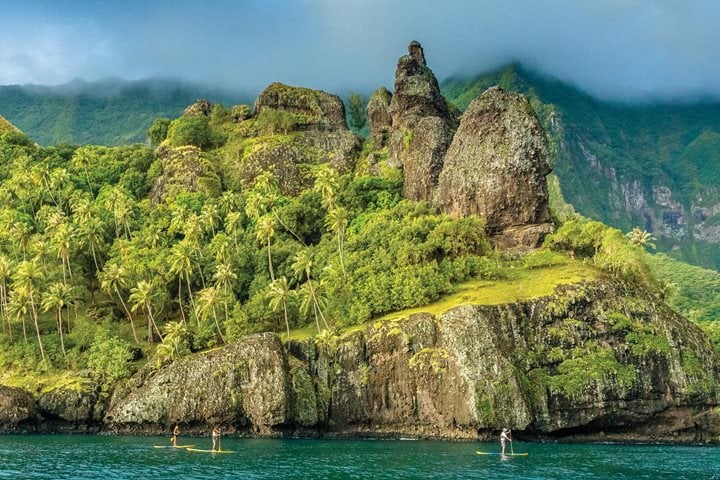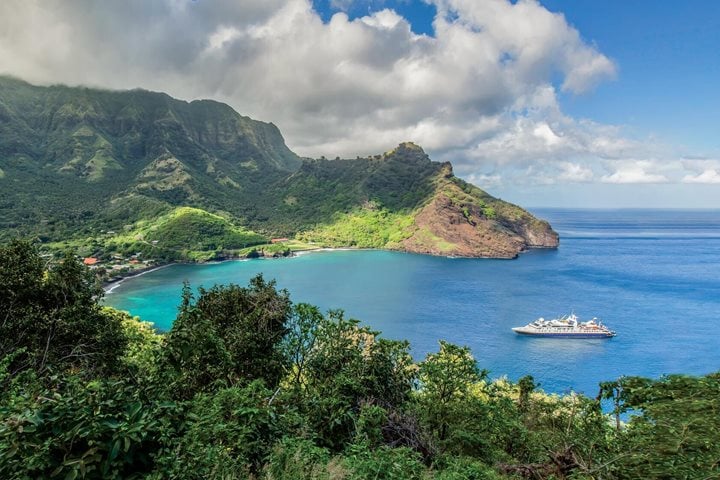Call +1.800.397.3348 or contact your travel advisor
- WorldView
- 5 Min Read
- 1 Aug 2019
How Travelers are Helping Scientists Study Manta Rays in French Polynesia
No matter how many mind-blowing manta ray photos you’ve seen on Instagram (#mantarays had over 49,000 posts at last count), nothing prepares you for the first time you spot one gliding past you in its watery natural habitat. A manta ray is one of the biggest fish in the ocean, with a wingspan that can stretch up to 30 feet wide and a hook-shaped cephalic fin that earned it the nickname “devilfish.” Though they might look a bit intimidating at first, the two species of manta rays—oceanic and reef, part of the genus Mobula—are both harmless to humans. Get Inspired By Photos, Videos, Webinars, Stories, And Exclusive Offers. Sign Up
Dives around the French Polynesian islands and other areas where manta rays are found can provide a fantastic opportunity to study these animals in their natural habitat. But the manta ray’s days might be numbered. Having evolved over 400 million years, longer than dinosaurs and modern trees, manta rays are vulnerable to extinction as a result of an onslaught of factors ranging from overfishing to pollution and climate change.
Luckily, manta ray conservation efforts are underway, especially in French Polynesia. Around the country’s more than 100 islands in the South Pacific, locals and visitors can get involved in learning about, tracking, and protecting these extraordinary animals.
Making friends with mantas
Manta rays have another nickname—“shark pancakes,” thanks to a physique that looks like a flattened shark. But don't let that worry you. Not only do manta rays pose no danger to divers, “they seem to have as much curiosity about us as we have about them," says Lindblad naturalist and expedition diver Maya Santangelo. She has experienced this curiosity firsthand: “I’ve spent an entire hour-long dive with just one manta, and you can tell there’s something home there."
The notion that manta rays are exceptionally intelligent is borne out by the animal’s brain size, which is larger in proportion to its body than any other fish. Mantas are the only creatures besides humans, apes, and dolphins to have passed the mirror test and recognized their own reflection.
Mantas also socialize and communicate with each other in unusual ways. Every manta has a unique pattern of white spots on its belly, which helps identify it to other animals. And those devilish-looking fins? “They're designed to help them feed on plankton,” says Santangelo, “but they’re used for social interaction as well. Studies in captivity have shown that the way mantas hold their fins can change, depending on what they’re doing.”
Why manta rays are in danger
Unfortunately humans are so captivated by manta rays, that we’re threatening their existence. One particular part of the manta ray that attracts too much attention for its own good is the gill plate. Mantas use this plate to filter out plankton and purge any inedible matter. “People are seeing that manta rays live for a very long time and have gills that filter out their food,” says Santangelo. “And they’re thinking, ‘If we eat this gill, it will filter out the bad stuff for us too.’”
Despite having no basis in science, the dubious new health tonics made from gill plates are finding a huge market in Asia, and leading to overfishing that’s threatening manta ray populations.
Bycatch, pollution, and climate change pose enormous threats as well. Like sharks, mantas must keep swimming in order to breathe, so getting caught in a fishing net is deadly. Mantas are also dying from ingesting ocean pollution, and climate change is endangering their habitats.
How citizen science can help
In French Polynesia, the plankton-rich waters and coral reefs attract huge populations of mantas, and these marine animals play a key role in the ecology, culture, and tourist economy. Thanks to local laws that protect manta rays, the islands of French Polynesia are an ideal place to spot them and help scientists track their individual movements.
Manta rays are fast swimmers, which makes them hard to study. But their individual patterns of spots make it possible to identify each manta and keep track of its comings and goings.
“We came across large aggregations of manta rays in the Marquesas Islands," says Santangelo. “This is one of the few places in the world that you can actually see both species of manta ray.”
Whenever Santangelo sees a manta ray, she tries to snap photos of its spots, and she encourages other divers to act as citizen scientists too. “The Lindblad trips are unique in that we get people in the water with us. I’m a divemaster, so I’m part of the dive team, and we take guests out scuba diving,” says Santangelo. “Simply by taking a photo, even with a GoPro, we can learn about these animals. You don’t have to be a scientist to contribute to science.”
Those images help specialists discover if the manta is a match with one already in the database, and can then measure the animals’ growth and movements. “I was just going through photos, and I got a match with an animal we saw the day before at over 100 kilometers away,” says Santangelo.
The manta ray tracking project is fairly new, she adds: “Manta rays have never been studied in French Polynesia before. One of the things I love about working with Lindblad is we get to travel to these incredible, remote areas. What comes with that is a huge opportunity and responsibility to contribute and give back to these special places.”
Learn more about manta rays when you travel with us to French Polynesia. Browse all of our South Pacific itineraries and discover what a day in the islands is like.



